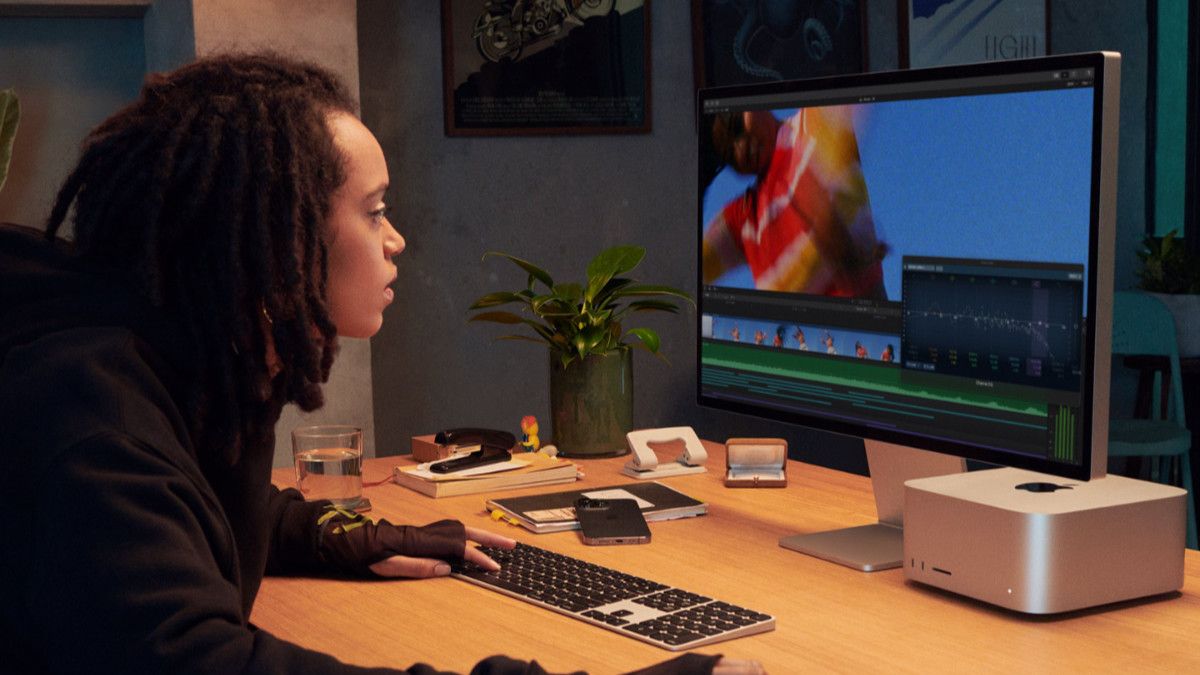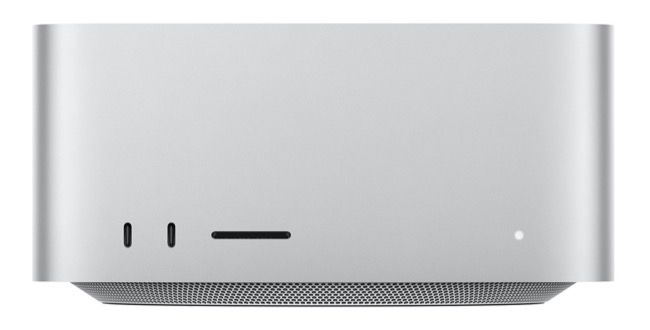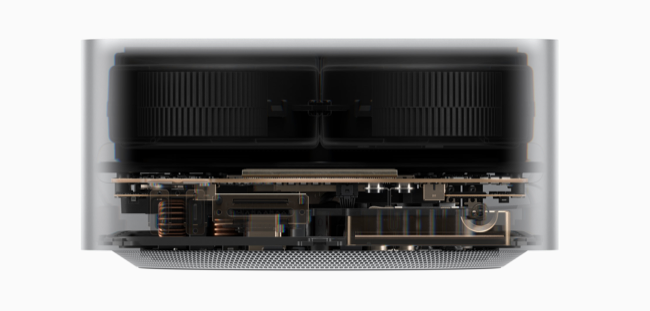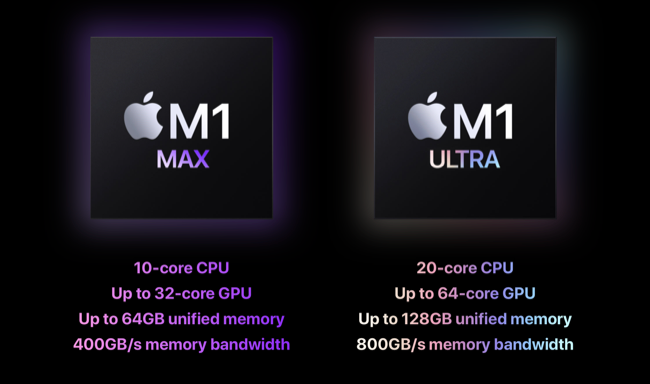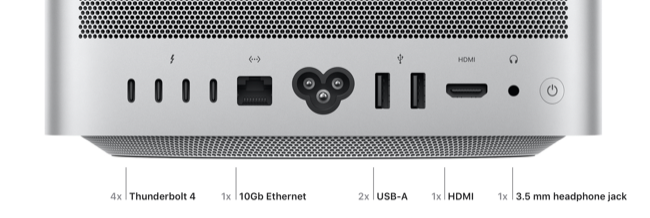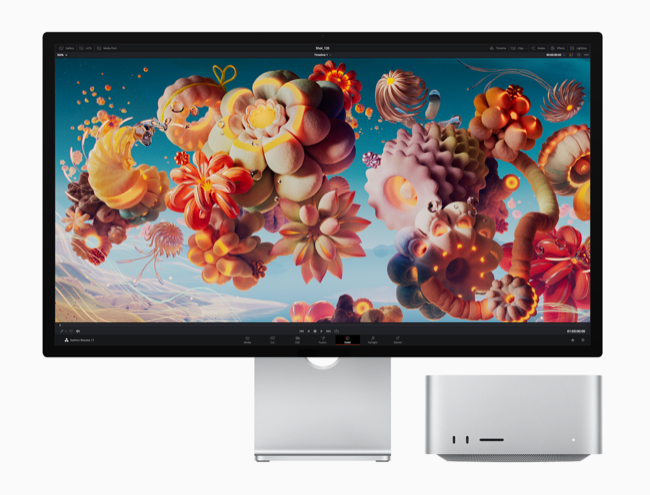Quick Links
As part of the transition to Apple's own in-house custom silicon, the company has started filling some gaps in its lineup. This includes a new powerful small form factor desktop machine called the Mac Studio.
So who is this "not quite a Mac Pro" for?
What Is the Mac Studio?
The Mac Studio sits somewhere between the Mac mini and Mac Pro. Those are two very different machines, with very different target audiences, not to mention form factors. But somehow the Mac Studio fits neatly into the chasm between them, offering serious performance in a relatively small desktop form factor.
It's the first seriously powerful desktop-class Mac that's equipped with an Apple Silicon processor. Until now only the Mac mini and iMac had received the Apple Silicon treatment, with only the entry-level M1 chip to choose from. This restricted professional workflows due to limitations on RAM, memory bandwidth, available GPU cores, and more.
The Mac Studio looks like a taller Mac mini on account of a new double blower active cooling system which Apple claims remains "whisper quiet" even under heavy workflows. There are two USB-C Thunderbolt 4 ports on the front and four on the back alongside two USB-A ports and an HDMI out. The Mac Studio can handle up to five displays, four over Thunderbolt and one using HDMI (though only 4K at 60Hz).
There's a built-in speaker, but you'll probably want to hook up your own using the 3.5mm audio jack. There's nothing but the Mac Studio and a power cord in the box, which means you'll need to supply your own display and peripherals (or add them when you check out).
Who Is the Mac Studio For?
The Mac Studio has both broad appeal and niche use cases. In essence, it's for anyone who needs more power than a Mac mini or iMac can provide who still wants a desktop form factor. Thus far in Apple's in-house silicon transition, this performance could only be found in the MacBook Pro line.
It's also likely to resonate with anyone who is tempted by the Mac mini. If you want a performant machine and aren't afraid to (or would rather) bring your display and peripherals with you, the Studio is an appealing prospect. It could be a nice iOS and macOS development machine to sit alongside your Windows desktop. It could be the ideal Mac for mechanical keyboard aficionados.
The Studio is also a good value proposition for someone who needs MacBook Pro performance without the portability. At $1999 the entry-level Mac Studio is around $1500 cheaper than a comparably-specced MacBook Pro. You're not paying for the display, keyboard, trackpad, or form factor.
If you've been eyeing the M1 Mac mini but wish it had a bit more RAM, a bit more GPU power, the ability to drive more monitors, or higher memory bandwidth; look no further than the Studio.
(Potentially) More Powerful Than a MacBook Pro
The base Mac Studio ships with the same M1 Max processor found in a top-specced MacBook Pro (though with a 512GB SSD, rather than 1TB as found in the MacBook). This will provide comparable performance to a laptop that costs $3499, with 10 CPU cores, 24 GPU cores, a 16-core Neural Engine, and 32GB of unified memory.
A more expensive $3999 version of the Mac Studio includes what Apple is calling the M1 Ultra. This effectively delivers the same power as two M1 Max chips combined, doubling the CPU cores to 20, GPU cores to 48, and so on. Apple also offers an upgrade to a 32-core GPU M1 Max or 64-core GPU M1 Ultra for those who need serious graphical power.
Since the M1 Ultra is basically two M1 Max chips glued together, memory bandwidth is also doubled to 800Mb/sec, providing even faster read and write speeds. Everything else is doubled too: two video decode engines (up from one), four video decode engines (up from two) and four ProRes encode and decode engines (up from two).
There are two other notable differences compared to the MacBook Pro. The first is the addition of two handy USB-A ports on the rear of the unit (there are none on the MacBook Pro). There's also a built-in 10Gb Ethernet port on the back of the unit, something you'll need a USB-C to Ethernet adapter for on the MacBook. Just like the MacBook Pro, there's an SDXC card reader for quickly accessing memory cards.
Not Quite the New Mac Pro
In 2020 Apple promised that it would transition its whole line of Mac computers to Apple Silicon within two years. While the Studio has some serious power, it's not the Mac Pro many users have been dreaming of. All signs suggest that the update is still to come, with Apple teasing the existence of the machine at the same March 2022 event it used to announce the Studio.
The M1 Ultra is the most powerful piece of Apple Silicon released to date, and the most powerful Mac ever made. In terms of power, the high-end configuration will out-perform the existing Intel-powered Mac Pro in most areas. In fact, the level of performance provided by the Studio is probably overkill for most users.
If you're not editing multiple streams of 4K or 8K video, building 3D worlds and VR applications, or using CPU-heavy data analysis tools, then the Apple Silicon may be surplus to requirements (even the M1 Max version). You could save some money with a Mac mini or iMac instead.
With this in mind, there's something to be said about buying a machine that's more powerful than what you currently need but that you may grow into or keep for a long time. This is particularly true when it comes to RAM and storage.
If you're looking at the Mac Studio and wishing it could do more, the Mac Pro update that's due out in a few months is probably worth waiting for. Or you could try your luck building a high-end Windows PC, provided you can get your hands on a CPU and GPU.
Pair It With the Studio Display
If you're feeling cashed up then Apple announced a new monitor alongside the Mac Studio (that works with any Mac with a Thunderbolt 3 output). Starting at $1599 for a 27-inch 5K Retina display, the Apple Studio Display effectively turns the Mac Studio into a more powerful iMac for around the price of a high-end MacBook Pro.
Alternatively, check out some of the best monitors you can buy right now.

